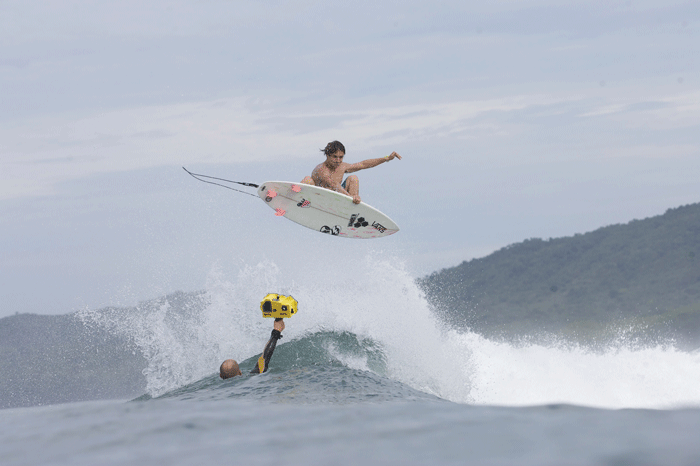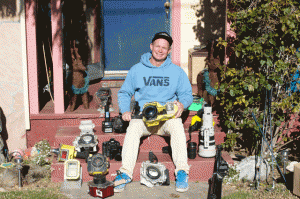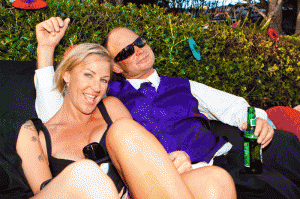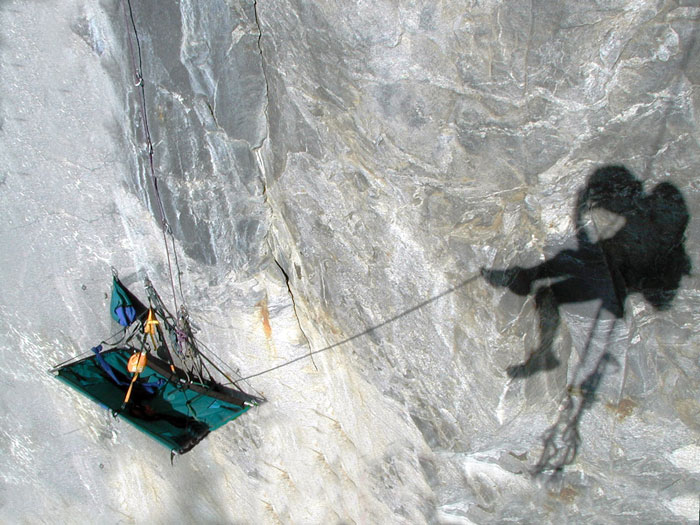- Tahoe’s Nevada Beach Tops the List of Hard-to-Book Campgrounds - 07/17/2024
- Cannabis Watershed Protection Program Cleans Up Illegal Grow Sites - 07/10/2024
- French Fire - 07/05/2024
Top Surf Photographer Dave “Nelly” Nelson has Spent his Career in the Impact Zone.
By Neil Pearlberg
A Pacific swell was firing on all cylinders in late April 2011 along Tahiti’s south west shore. For forty-five year old Santa Cruz surf photographer Dave “Nelly” Nelson it was to be another day at the office, or so he thought, when he paddled out with his gear, to capture surfing’s elite, riding one of the world’s most powerful ocean waves.
The wave at Teahupoo, whose English translation reads, “to sever the head,” is itself responsible for five surfing deaths since 2000. This fact alone serves notice to those who surf there, that there cannot be any lack of judgment, nor any mistake made, once they paddle into one of the 12-15 foot vertical slabs that violently break onto the shallow coral reef.
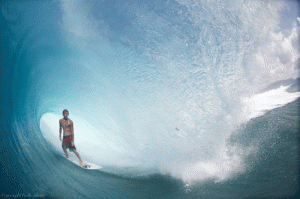
After three hours of constant swimming and dodging bombs, Nelly finally hooked up with John John in this huge barrel in Micronesia. He knew right away this picture would be special. Photo by: Nelly.
Nelly worked on getting the shot, inching ever closer to the hollow tube, looking for a chance to get the one shot that may land on the front cover of a surf magazine.
“Mick Fanning shot left and rail-grabbed his board while screaming down the line towards me, and as he flew by, I looked out to sea and realized that I was dead in the sights of a monstrous rogue wave hurtling in from the normally calm West Bowl,” said
Nelly, describing what happened on his last visit there.
“That wave is thick and impenetrable, and I sat directly in its path,” Nelly continued, “My life flashed before me, as I inhaled a huge breath of air, right before the wave jettisoned me up its face, then slammed and pinned me against the ocean floor.”
His predicament was far from over. Held there for what seemed like an eternity, he now needed to take his next breath.
“It was like a nightmare where you are unable to move, the clock was ticking, and I was beginning to panic,” Nelly said, “Then suddenly the force of the ocean current that pulled me down like a ship’s anchor let go, and with my burning lungs I scrambled to the surface for the first gasp of air, praying there was not another oncoming wave.”
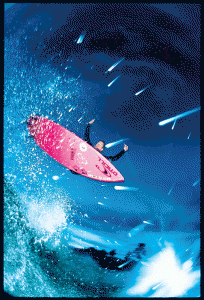
Jason 'Ratboy' Collins has always been one of Nelly’s favorite surfers. His style is one of a kind, in and out of the water. Photo by: Nelly
Shooting surf photos at locations like Tahiti, Hawaii, Bali and Mexico — to name but a few — would seemingly depict a Hollywood-esque world of glamour and paradise. However for the man behind the fish eye lens there is no danger pay, no stuntman money, and nothing is earned until a publication prints the shot.
At the tender age of five, young Nelly received a Kodak, “Brownie” camera from his mother, a small gift that would have an impact on his future. For the next ten years wherever Nelly went with his surfing and skateboarding friends, the sturdy Brownie went with him.
Upon graduating from Saratoga High in 1984, Nelly, armed with a more professional camera, moved to one of the epicenters of surf and skate culture, the Pleasure Point neighborhood in Santa Cruz. Surf photography was well represented there with the likes of Tony “T.R.” Roberts, Chris Klopf, and Bob Barbor, all who covered the Santa Cruz beaches and surf, shooting the high flying acts of the pro surfers in the small seaside town.
Usually within any success story, a little bit of luck will play a role, and for Nelly good fortune came calling.
T.R. Roberts, who mentored Nelly in the intricacies of surf photography, one day knocked on his protégé’s front door to share the news that he was moving to Costa Rica. On the spot, he sold him his prized camera water housing, handed over all his contacts and a host of other photographic equipment, and just said, “Run with it, Nelly. You have the eye to be one of the best.”
Nelly’s luck continued when four of Santa Cruz’s top surf photographers made life changes within a brief span just as he was getting his feet wet behind the lens. Along with Roberts’ move to Costa Rica, Chris Klopf moved to Humboldt, Ron Edwards moved to Tahoe, and Bob Barbour changed careers.
“All of a sudden I was the only one taking photos in Santa Cruz,” Nelson said. “So I took full advantage of what fell into my lap, making sure that on every sunny day I was out there shooting.”
For any aspiring surf photographer or surfer, Nelly will gladly share with you his recipe for success. “Make friends; connections are the key to being successful in this sport,” he said. “You may see yourself as a talented photographer or surfer, but if you aren’t connected, you will go nowhere.”
“Go to contests, always stay involved, and if you have talent, the word will spread,” he explains.
The Santa Cruz professional surf crew, including names like Matt “Rocky” Rockhold, Shawn “Barney” Barron, and 2013 Mavericks Invitational Champion Peter Mel, all made their way into Nelly’s 600 mm lens, the surf world took notice, and the word traveled fast.
It didn’t take long for the giants of the surf industry to come calling. O’Neill, Vans, Sector 9, Santa Cruz Surfboards, and Transworld Surf all vied for Nelly’s work, followed by some of surfing’s elite athletes.
Kelly Slater, Mick Fanning, Pat Gudauskas, Clay Marzo and the “four million dollar man” twenty-year old John John Florence liked to display their talents in front of Nelly’s lens. His innovative methods of capturing high flying aquatic acts with cameras mounted on boards, along with different color flashes and strobes, took action surf photography to the next level.
“Nelly is an absolute legend,” said ASP World Tour competitor Gudauskas. “His passion for risk and reward photography equals my froth to surf, and together we have had a blast creating insane images and artwork — he will always be one of my favorite photographers to work with.”
Now admittedly slowing down, Nelly is no longer chasing surfers all over the planet to get a cover shot. “Times are changing in the surf industry, and nowadays a photographer has to be better on a computer than behind a lens,” he said.
“It used to be 90% photography and 10% figuring out where to send it. Today, it is 30% photography, and then it’s a race to the beach to get your computer where you spend the other 70% of your time on Photoshop to perfect the photos you send to magazines.”
Often called the world’s deadliest wave, Banzai Pipeline, on O’ahu’s North Shore, remains Nelly’s favorite surf break to shoot.
“I am still going to swim out at Pipe, I am just not going to risk my life over it,” said Nelly, who goes on to describe the three reefs at Pipeline, each coming alive according to the increasing size of ocean swells.
“The first reef is the most dangerous because the wave breaks in extremely shallow water. At the second reef, the wave rolls in, breaks, and then mushes into the first wave,” Nelly described. “If you see the wave rise up at the third reef, then you have 30 seconds to swim sideways toward Rocky Point, before it sweeps in and mows everyone down.”
“Getting worked, and pounded by a huge set that rolls though Pipeline, with no guarantee that my photos will be used, is not something I am keen on doing much anymore.”
Having shot photos in exotic, treacherous locations like Teahupoo, Puerto Escondido, and Pipeline, the question most commonly asked of the man behind the lens is, “Have you swam out to shoot the behemoth in your own backyard?”
The infamous break at Half Moon Bay is simply not on his list. “The wave at Mavericks is a football field long, a mile out to sea, it’s freakin’ cold, and large sharks like to keep you company. Adding to the danger is getting caught in the wrong position, where a wave the size of a five-story building will hunt you down, explode on you, and finish you off by sucking you down into the abyss. Swimming out there is just dumb.”
Although still traveling to get the shot, nowadays Nelly spends more time in Santa Cruz to be nearer my wife Kristy and daughter Kiala. “I want to be around to watch my daughter grow up, coach her teams, and teach her what I know, while she teaches me!” He said
As he considers his legacy, Nelly is now seeing a growing market in presenting his surf photography to an audience beyond surf magazine readers. Ready to capitalize on the national interest in surfing, he believes in placing a value on his work — and the work of his fellow surf photographers — that factors in the danger of getting the shot.
Much of Nelly’s unique surf photography is now framed and displayed at Dogmatic Fine Arts in Capitola, and will soon be shown at the Rite Spot in San Francisco, as well as the La Madrona Tennis & Racquet Club in Scotts Valley.

